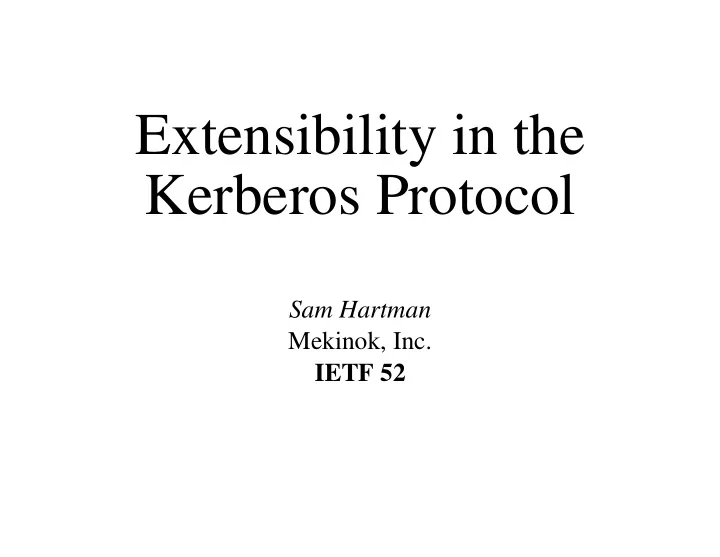

Extensibility in the Kerberos Protocol Sam Hartman Mekinok, Inc. IETF 52
Table of Contents Slide Title Slide# I. Why Extensibility? 4 Arguments for Extensibility 5 Protocol Requirements from Vendors 6 IETF Concerns About Vendor Extensibility 7 Evolution of the Protocol within the IETF 8 Mechanisms to Support Protocol Evolution 9 II. Kerberos Extensibility Track Record 10 Extensibility Proposals Presented at IETF 11 Where these Extensions Stand Today 12 Common Problems with Extensions 13 Why Avoid Negotiation 14 III. A General Solution 15 Why can we do better with a general solution? 16 Goals of Our General Solution 17 ASN.1 Extensibility Allows IETf Protocol Evolution 18 Meeting Vendor Needs with Typed Holes 19 Protecting Cleartext with Signed Type 20 The Golden Rule 21 Determining Capabilities of a Recipient 22
Table of Contents
I. Why Extensibility?
Arguments for Extensibility • Vendors need extensibility to get technologies to market. • The IETF needs extensibility to change the protocol while maintaining backward-compatibility. Sam Hartman - Extensibility in the Kerberos Protocol Slide 5
Protocol Requirements from Vendors • Vendors choose standards based on what is available when they start a project. • Market forces may make a new technology critical at any time. • Waiting for standard changes is not an option. Sam Hartman - Extensibility in the Kerberos Protocol Slide 6
IETF Concerns About Vendor Extensibility We want vendors to be able to use our standards, but in such a way that interoperability between vendors is maintained. Sam Hartman - Extensibility in the Kerberos Protocol Slide 7
Evolution of the Protocol within the IETF Developing a new, incompatible protocol to make changes has high cost. Thus, the IETF needs to be able to extend the protocol in future. Sam Hartman - Extensibility in the Kerberos Protocol Slide 8
Mechanisms to Support Protocol Evolution • Mechanism for making phased upgrades to core protocol messages • Extensibility model that minimizes likelihood of changes today precluding other important changes in the future Sam Hartman - Extensibility in the Kerberos Protocol Slide 9
II. Kerberos Extensibility Track Record
Extensibility Proposals Presented at IETF • Kerberos error checksums (IETF 38) • Ticket extensions (IETF 39) • Authorization Data clarifications (IETF 39) • Make some fields optional • Checksum of AS-REP • Crypto system selection Sam Hartman - Extensibility in the Kerberos Protocol Slide 11
Where these Extensions Stand Today With the exception of crypto system selection, none of these extensions work in an interoperable manner. Many have been removed from the draft pending a better solution; others would present significant problems if implemented. Sam Hartman - Extensibility in the Kerberos Protocol Slide 12
Common Problems with Extensions • Many proposed extensions assume fields can be added to ASN.1 sequences. Unfortunately, doing so breaks backward compatibility. • Significant effort was spent trying to avoid adding capability negotiation to Kerberos. As such, clients cannot tell whether extensions they want to use are supported. • Extensions were considered one-at-a-time; we didn't take advantage of common elements. Sam Hartman - Extensibility in the Kerberos Protocol Slide 13
Why Avoid Negotiation • Negotiation adds complexity. • Negotiation often adds round trips • Negotiation is harder in Kerberos than other protocols because Kerberos involves three parties. The KDC must know the capabilities of the service. Sam Hartman - Extensibility in the Kerberos Protocol Slide 14
III. A General Solution
Why can we do better with a general solution? • Storing one bit of state on the KDC to facilitate general negotiation is reasonable, even if storing a bit for each option is not. • We can spend more time reviewing the ASN.1 for a general solution than for any specific option. • We can abstract out common elements of proposed extensions. For example, we can solve all instances of authenticated cleartext rather than specific cases. Sam Hartman - Extensibility in the Kerberos Protocol Slide 16
Goals of Our General Solution • Provide the IETF with a mechanism for future protocol evolution. • Provide vendors with hooks to extend the protocol in interoperable ways. • Provide a means to authenticate cleartext carried in Kerberos messages. Sam Hartman - Extensibility in the Kerberos Protocol Slide 17
ASN.1 Extensibility Allows IETf Protocol We add ASN.1 extension markers to most Kerberos messages. • New fields can be added to the end of messages • Not useful for vendor extensions because we must coordinate tag assignment; only the IETF can take advantage of the ASN.1 extensibility markers. Sam Hartman - Extensibility in the Kerberos Protocol Slide 18
Meeting Vendor Needs with Typed Holes • Typed holes (sub-messages that contain an octet-string along with an integer that defines how to interpret the octet-string) were added to messages that did not already have them. • Vendors and the IETF can use these holes to add new extensions. Sam Hartman - Extensibility in the Kerberos Protocol Slide 19
Protecting Cleartext with Signed Type • Messages containing cleartext fields have been wrapped in types containing keyed checksums. • Guidelines clearly specify when checksums should be sent and what key is used. • A checksum is added to the AS-REP in order to authenticate the AS-REQ. Sam Hartman - Extensibility in the Kerberos Protocol Slide 20
The Golden Rule Be liberal in what you accept and conservative in what you send. New Messages should only be sent when they will be understood by the recipient. Recipients should ignore extensions they do not understand, preserving them if the message is reencoded. Sam Hartman - Extensibility in the Kerberos Protocol Slide 21
Determining Capabilities of a Recipient • If you have received a new-format message then you can send new-format messages. • The ticket type tells the client about server capabilities. • For bootstrapping, a new AS-REQ can be included in an old AS-REQ. Sam Hartman - Extensibility in the Kerberos Protocol Slide 22
Recommend
More recommend